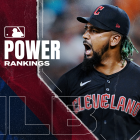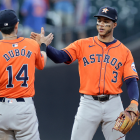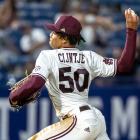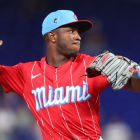The Orioles have remained in contention despite, for much of the year, getting pretty lousy starting pitching behind Chris Tillman. This hasn't dragged them down just yet thanks to the power in the lineup, the lockdown bullpen, and Buck Showalter's expert deployment of that lockdown bullpen.
Still, when the deadline addition of Wade Miley plausibly constitutes an upgrade, it's telling. But Miley's adequacy or quasi-adequacy probably won't be what determines whether the Orioles have enough of a rotation to make the playoffs. Rather, it may be a 23-year-old one-time elite prospect who's possibly and finally realizing his immense potential.
We speak, of course, of right-hander Dylan Bundy, who shoved it Tuesday night against a revamped Rangers lineup: 7.0 IP, 1 H, 0 R, 7 SO, 1 BB. That effort lowered Bundy's 2016 ERA to 3.05, and he's now struck out 56 batters in 59.0 innings against just 13 unintentional walks.

After spending the first half of 2016 in the bullpen, Bundy made his first career big-league start on July 17 against the Rays, and he was knocked around over the course of 3 1/3 innings (he walked three batters and allowed three homers over that span). In the three starts since then, though, he's run a 1.53 ERA with 20 strikeouts and two walks.
Bundy's a fastball guy, which is understandable given that his four-seamer sits at 96. However, he's also got command of a change, curve, and sinker. The change, of course, is the platoon-busting pitch, and pretty much every starter needs one of those.
With that in mind, here's a look at how Bundy has attacked left-handed batters over the first three starts of his career (i.e., including that first bad start but not including Tuesday's gem):

As you can see, Bundy has increased his changeup usage against the opposite side as the season has gone on. It's a feel pitch, of course, and one assumes based on the trend-lines above that Bundy's feel for the change is improving.
While acknowledging we're dealing with tiny sample sizes, we'll point that lefties in that first start batted .500 against Bundy's change. In the next two starts, that figure dropped to .125 and .167, respectively. Against Texas, the changeup was again Bundy's favored No. 2 pitch, and on a night when he dominated said No. 2 pitch had the highest percentage of swings and misses of any of his offerings.
As Bundy recently told Jon Meoli of the Baltimore Sun, he didn't have a changeup until he was a pro, and even then he didn't really want one:
"The organization wanted me to throw it in Low-A when I didn't need to. It was just for development purposes, and I get that now. But of course, I didn't like throwing it, because they could hit it."
Obviously, Bundy wound up listening, and early indications are that the changeup has helped become an effective starting pitcher at the highest level.
It would be one thing if Bundy were a garden-variety young arm enjoying a sparkling three-start stretch, but he's long had the potential for greatness. The fourth-overall pick of the 2011 draft, Bundy's been a highly regarded prospect for what seems like forever. Take a look at this Baseball-Reference screengrab that shows his overall ranking each year ...

Yep, he's a regular. After all, Bundy was once a 19-year-old who made onlookers gasp at his curveball ...
And that may be his third-best pitch these days.
It bears repeating that this is short-run success we're talking about, so sustainability is not be assumed. However, it's easy forget that Bundy, after Tommy John surgery followed by shoulder problems ushered him from our consciousness, was once one of the most promising young pitchers in baseball. If (very) recent history is any guide, he may still be that. So, yes, the Orioles may have landed the pitcher they need, except this one was already there.


















